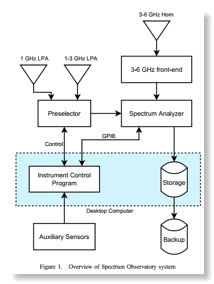IIT's Spectrum Observatory: Some Questions Its Data Could Answer
While traveling this week I visited the Illinois Institute of Technology in Chicago and met with Dennis Roberson, an old acquaintance who had invited me to give a seminar. Dennis showed me around the beautiful Mies van der Rohe-designed campus and kindly arranged that the seminar be given in S. R. Crown Hall , a National Historic Landmark designed by van der Rohe.
I was particularly fascinated by the NSF-supported Spectrum Observatory that Dennis has described as follows:
Spectrum is a scarce natural resource that we depend on to an ever increasing degree for our social interactions, our protection and emergency services at the national and global level and the efficient conduct of business both here and around the world. This resource is extremely valuable commanding prices in the U.S. in the range of $250,000,000 per MHz for prime spectrum property. Even the President has become directly involved in an effort to move 500 MHz of spectrum to commercial broadband providers (usually cell phone service providers) in an attempt to spur economic growth, create jobs and to help to resolve the Federal Budget deficit. Given its value and importance, surprisingly little is really known about the current usage and the trends in the spectrum occupancy in the various geographies in the U.S. and around the world. To help resolve this issue, Illinois Institute of Technology through its Wireless Network & Communications Research Center (WiNCom) developed a Spectrum Observatory to monitor the spectrum occupancy in the "Loop," the business center of the City of Chicago.
As shown at left, the Spectrum Observatory covers 30-6000 MHz. It has been operating since July 2007 from a 22 story site at the IIT campus a few km south of the downtown Chicago. The basic arrangement and some of the data collected are reviewed in a DySPAN 2011 paper.
225-400 MHz Band Data. Some data in the DySPAN paper shows occupancy in the 225-406 MHz band. A previous post here reviewed NTIA’s disinterest in reviewing occupancy of this band although it has reviewed occupancy of nearby federal bands. 225-400 MHz is mostly a military aeronautical mobile band. There are some other things in it including mobile satellite links that go back to the Cold War.
There is a military base in downtown San Diego that uses this band, but not in other urban areas where there are a real spectrum shortages. Shared use of 225-400 MHz, perhaps on an interruptible spectrum basis, could help add spectrum to meet real US needs. NTIA’s reluctance to explore this by collecting data shows the basic problem of US spectrum policy in the current arrangements and the need for the recent PCAST federal spectrum recommendations. But to explore the feasibility of shared use we need real data on its present use and the IIT data is a great step in the right direction. Preliminary analysis in the DySPAN paper shows that for the period 2008 - 2010 the occupancy of 225-406 MHz had a maximum less than 20%. This initial analysis could be a good starting point for more detailed analysis by FCC and NTIA of this NSF-funded data collection.
Estimating Radio Noise Trends. Another interesting question that might be addressed from this unique data source is long range trends in spectrum noise. There is anecdotal evidence that it is increasing, but no real data. TV channel 37, 608-614 MHz, is a primary radio astronomy allocation and is basically unused - although this is some minimal licensed use for critical care medical telemetry in hospitals. A long term examination of this or other channels that should not be used in Chicago could reveal hard data on whether background noise is urban areas is changing.
===
The IIT Radio Observatory is a unique resource and kudos to IIT for proposing and operating it and to NSF for funding it. Unfortunately it is not that well known despite several published papers. Hopefully better understanding of this resource can lead to more informed spectrum policy decisions. But then again I once had a boss at FCC who was head of OET who said “Never ask a question unless you are prepared to hear the answer.”
UPDATE
See http://www.marcus-spectrum.com/Blog/files/SpecMeasCorr414.html




![Validate my RSS feed [Valid RSS]](valid-rss-rogers.png)

